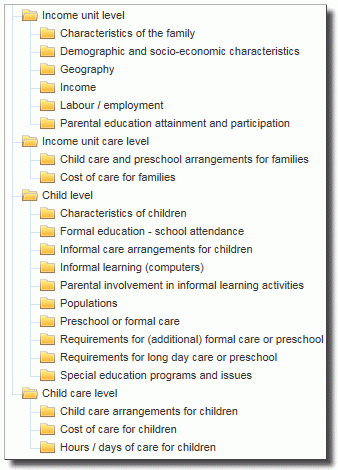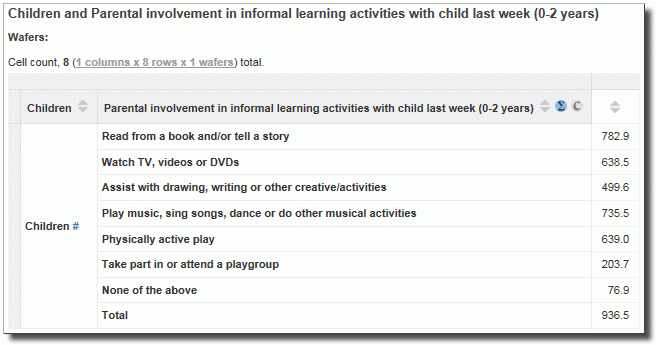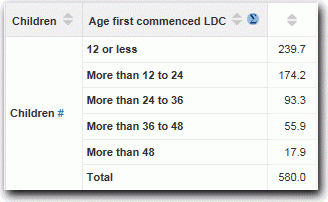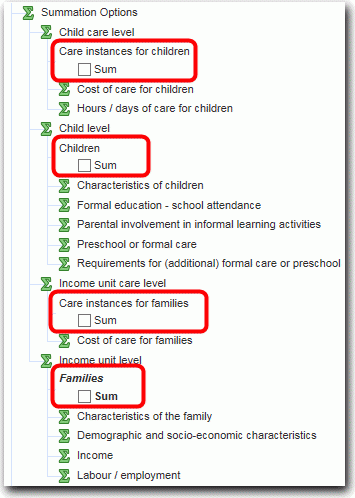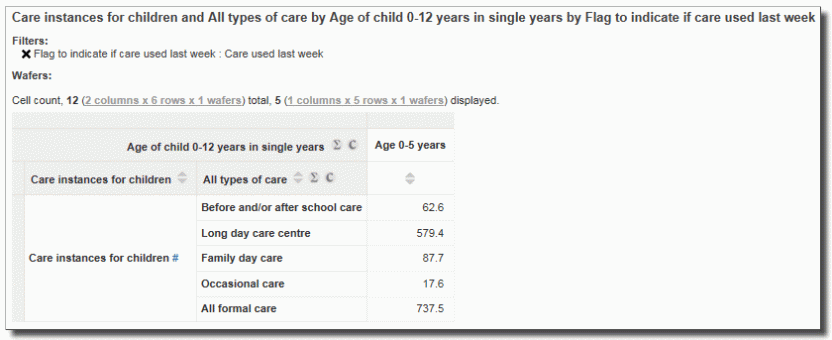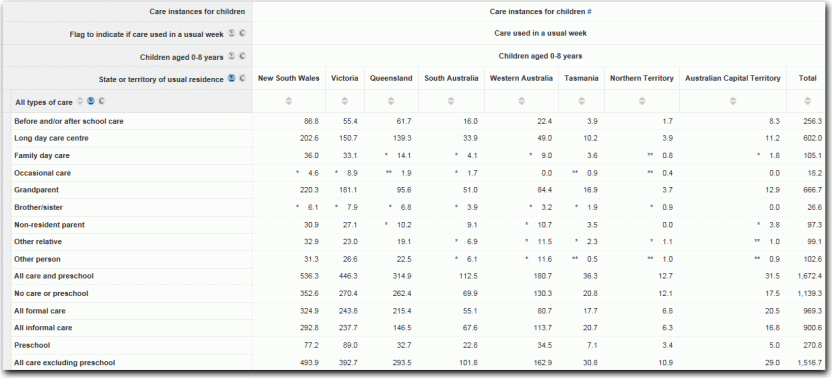Actively involved
Active parental involvement refers to parents' behaviour during the activity. Actively involved parents take part in the activity with the child. For most activities, this excludes simply watching the child engaging in the activity. However, transporting the child to and from sport, outdoor games or other physical activities and remaining with the child during the activity, are included.
Additional formal care or preschool required
Includes instances in which children were already attending care or preschool and parents wanted them to attend more, as well as instances in which children did not attend any care or preschool and parents wanted them to attend. Does not include instances in which parents want to change service providers but not type or quantity of service.
Approved care
Child care providers that meet the requirements of the Australian Government quality assurance system, such as having a license to operate; qualified and trained staff; and meeting health, safety and other quality standards.
Before and after school care
Care provided for school aged children before school, after school, during school holidays and on 'pupil free days'. Estimates of children's attendance at before and after school care include children who attend only before school care, only after school care, or both.
Books
Includes all book types including fiction, non-fiction, text books, recipe and reference books. Also includes e-books or books on e-readers, such as a Kindle. Books borrowed from the library or elsewhere are also included, but audio books are not.
Child Care Benefit (CCB)
Assistance in the form of a payment made by the Australian Government to help with the costs of child care for families who use a child care service approved by, or registered with, the government.
Child Care Rebate (CCR)
The Child Care Rebate covers 50 per cent of out-of-pocket child care expenses for approved child care up to the maximum legislated amount per year per child. The Child Care Rebate is available to families who have used approved child care during the year, been eligible for Child Care Benefit and have passed the work, training, study test some time during the week the approved care was provided.
Computer
Includes portable and desktop computers (e.g. laptops, notebook computers), as well as devices with computer-type functions (e.g. tablets, iPods, smartphones). Also includes computers brought home from work and games consoles, such as Playstations and Xboxes.
Cost of care
Within this publication, cost of care is reported as the net cost of care to the parents after the CCB and CCR have been deducted.
Couple family
A couple family is based on two persons who are in a couple relationship and who are usually resident in the same household. To be included in CEaCS, a couple family must also have at least one child aged 0-12 usually resident. A 'couple relationship' includes same-sex couples.
Family
A family is defined as two or more persons, one of whom is at least 15 years of age, who are related by blood, marriage (registered or de facto), adoption or fostering; and who are usually resident in the same household. Only families with children aged 0-12 years are included in CEaCS. Note that while the word 'family' is often used interchangeably with 'income unit' in CEaCS, the income unit may not include all members of a family, as only information on parental income is collected. For example, a child aged 15 years or over living at home with their own income source is not included in the income unit, but is included as a member of the family.
Family day care
A type of formal care provided in the home environment of a registered carer.
Father
The male parent or guardian usually resident in the same household as the child.
Formal care
Regulated care away from the child's home. The main types of formal care are:
- long day care,
- before and/or after school care,
- family day care,
- occasional care.
Full-time/part-time workers
Full-time workers are employed persons who usually work 35 hours or more a week as well as those who, although they usually work less than 35 hours a week, worked 35 hours or more during the survey reference week. Part-time workers are employed persons who usually work less than 35 hours a week and who did so during the survey reference week.
Government establishment
Includes any preschool/kindergarten conducted or managed principally by a state, territory or federal government agency.
Household
A household may consist of a single person, one or more families, or one or more unrelated persons, who are usually resident in the same private dwelling. In CEaCS, where multiple family households were included in the survey sample, only one family per household was selected for enumeration.
Income unit
An income unit in CEaCS equates to a family of one or more parents and any other dependent family members, including dependent children aged 0 to 12 years. Information regarding income is collected only from parents in selected families and does not include income from any other family members.
Informal care
Non-regulated care either in the child's home or elsewhere. It includes paid or unpaid care by:
- (step) brothers or sisters,
- grandparents,
- other relatives (including a non-resident parent),
- other people such as friends, neighbours, nannies or babysitters and other organisations (e.g. crèche at gyms and health centres).
Informal learning
Unstructured learning activities that occur in daily life, such as reading, musical activities and physical activities.
Last week
The survey reference week. For interviews conducted between 11 and 17 June 2017, the reference week was 4 to 10 June. For interviews conducted between 18 to 24 June, the reference week was 11 to 17 June.
Long day care
A centre-based form of child care service providing all-day or part-time care for children.
Mean
The mean is a measure of central tendency often referred to as the 'average'. The mean of a variable is calculated by summing the values of all observations in a data set and then dividing by the number of observations in the set. The mean is a good choice of measure of central tendency when the data is symmetrically spread out from the lowest to highest value (i.e. evenly distributed). However, the mean is not a good measure when the data is unevenly distributed. For more information see Statistical Language!, 2008 (cat. no. 1332.0.55.002).
Median
The median is another measure of central tendency - it is the middle value that separates the higher half of the data set from the lower half. To calculate a median, the observations of a variable are ordered by value and the median value corresponds to the middle observation of that ordered list. When compared to the mean of a variable, the median can illustrate a skewed or uneven distribution. However, as the median only reports the middle observation of the data, it may hide the presence of extreme values. For more information see Statistical Language!, 2008 (cat. no. 1332.0.55.002).
Mother
The female parent or guardian usually resident in the same household as the child.
Multiple response
Indicates that more than one category can be chosen for a particular data item.
Non-government establishment
Includes any preschool/kindergarten conducted or managed by a non-government institution or organisation, including a Catholic school or preschool/kindergarten or an independent school or preschool/kindergarten.
Non-resident parent
A child's natural or adoptive parent who is not usually resident in the same household as the child.
Occasional care
Services usually provided at a centre on an hourly or sessional basis for short periods or at irregular intervals.
One parent family
A one parent family is based on a person who has no spouse or partner usually present in the household, but who forms a parent-child relationship with at least one child usually resident in the household. To be included in CEaCS, a one parent family must have at least one child aged 0-12 years usually resident.
Parent/guardian
Natural, step, foster or adoptive parents are considered parents in CEaCS. A guardian is a person who has the designated responsibility for a minor child, whether or not it is a legal or informal arrangement. In this publication, when the term 'parent' is used, this includes guardians.
Preschool or preschool program
A preschool program is a structured, play-based education program, delivered by a degree qualified teacher, primarily aimed at children in the year before they commence full-time schooling. The program may be delivered in a dedicated preschool, a long day care centre or a school.
Registered care
Child care provided by persons and institutions that are registered with the Department of Human Services as registered care providers.
Remoteness
The Australian Statistical Geography Standard (ASGS) was used to define remoteness. The Remoteness Structure is described in detail in the publication Australian Statistical Geography Standard (ASGS): Volume 5 - Remoteness Structure, July 2011 (cat. no. 1270.0.55.005).
School age
Whether a child is eligible to attend primary school is determined by age and varies by state or territory. The age requirements in 2017 are listed below:
NSW - aged 5 years or older on or before 31st of July 2017
VIC - aged 5 years or older by 30th of April 2017
QLD - aged 5 years or older by 30th June 2017
SA - aged 5 years or older by 30th of April 2017
WA - aged 5 years or older on or before 30th June 2017
TAS - aged 5 years or older on or before 1st January 2017
NT- aged 5 years or older before 30 June 2017
ACT- aged 5 years or older by 30th of April 2017
Socio-Economic Indexes for Areas (SEIFA)
SEIFA in CEaCS 2017 is a suite of four indexes that have been created from social and economic information provided by the 2011 Census. Each index ranks geographic areas across Australia in terms of their relative socio-economic advantage and disadvantage. The four indexes each summarise a slightly different aspect of the socio-economic conditions in an area. For each index, every geographic area in Australia is given a SEIFA score which measures how relatively 'advantaged' or disadvantaged' that area is compared with other areas in Australia. Information about SEIFA and how to use them is available in the publication Census of Population and Housing: Socio-Economic Indexes for Areas (SEIFA), Australia, 2011 (cat. no. 2033.0.55.001).
Weekly income of parents
Total gross income received from all sources by the parent or parents in the family.
Work arrangements
Arrangements such as flexible working hours, or working from home, used by employed parents to assist them to care for their children.
